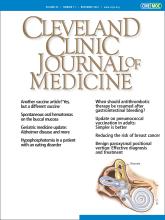Article Figures & Data
Tables
Age 50 or younger
Ovarian cancer (at any age)
Triple-negative breast cancer (at any age)
Male breast cancer (at any age)
Multiple primary breast cancers
Pancreatic cancer
Metastatic prostate cancer
Three or more diagnoses of breast cancer in the patient or a close blood relative
Two or more close (first-degree) relatives with breast or prostate cancer at any age
To aid in treatment decisions using poly(adenosine diphosphate-ribose) polymerase (PARP) inhibitors in patients with metastatic or very-high-risk breast cancer
Lobular breast cancer with a personal or family history of diffuse gastric cancer
Ashkenazi Jewish ancestry
Finding of a mutation in somatic tumor testing
A patient without a cancer diagnosis but with a first-, second-, or third-degree relative meeting the above criteria: Exceptions: 1) If patient is eligible for PARP inhibitors; 2) If patient meets testing criteria based only on pancreatic cancer or metastatic prostate cancer, the affected relative must be a first-degree relative
Based on information in references 5, 7, and 8.
Gene with pathogenic variant Estrogen-receptor–positive tumor Estrogen-receptor–negative tumor Triple-negative tumor BRCA1 Increasingly positive after age 50 +++ particularly before age 50 +++ particularly before age 50 BRCA2 ++ Over-representation,a but still primarily estrogen-receptor–positive Over-representation,a but still primarily estrogen-receptor–positive PALB2 ++ Over-representation,a but still primarily estrogen-receptor–positive Over-representation,a but still primarily estrogen-receptor–positive ATM +++ CHEK2 +++ CDH1 +++ TP53 +++ BARD1 +++ +++ RAD51C +++ +++ RAD51D +++ +++ ↵a Estrogen receptor tumors are more common than in the general population but are still not the predominant type of tumor pathology.
+ = relative prevalence
- TABLE 3
Medications used for breast cancer risk reduction: A brief summary of clinical trials
Trial N Eligibility HRa HRb NNT NSABP P-1
5-year trial
Tamoxifen 20 mg vs placebo3313, 388 Pre- and post-menopausal; Gail model-estimated 5-year risk ≥ 1.66% 0.51 0.14 for AH; 0.44 for LCIS 22 IBIS-1
5-year trial
Tamoxifen 20 mg vs placebo487,154 Pre- and post- menopausal; 50% on hormone-replacement therapy 0.75; with long-term follow-up 0.71 Not stated Not stated STAR P-2
5-year trial
Tamoxifen 20 mg vs raloxifene 60 mg34,5019,747 Postmenopausal Equal at 5 years; with long-term follow-up; raloxifene = 0.62 Equal Not stated (about 22) MAP.3
3-year trial
Exemestane 25 mg, exemestane 25 mg plus celecoxib, vs placebo464,560 Postmenopausal 0.35 0.36 (for AH/LCIS combined) 26 at 5 years IBIS II
5-year trial
Anastrozole 1 mg vs placebo473,864 Postmenopausal 0.47 0.31 (for AH/LCIS combined) 29c Low-dose tamoxifen
3-year trial
Tamoxifen 5 mg vs placebo49500 Pre- and post menopausal; included patients with ductal carcinoma in situ 0.48 Not stated 22 ↵a For reduction in invasive breast cancer.
↵b For reduction in invasive breast cancer in patients with AH and LCIS.
↵c To prevent 1 cancer in 7 years of follow-up, 36 women would need to be treated.
AH = atypical hyperplasia; HR = hazard ratio; IBIS = International Breast Cancer Intervention Study; LCIS = lobular carcinoma in situ; MAP = Mammary Prevention trial; NNT = number needed to treat; NSABP = National Surgical Adjuvant Breast and Bowel Project; STAR = Study of Tamoxifen and Raloxifene






